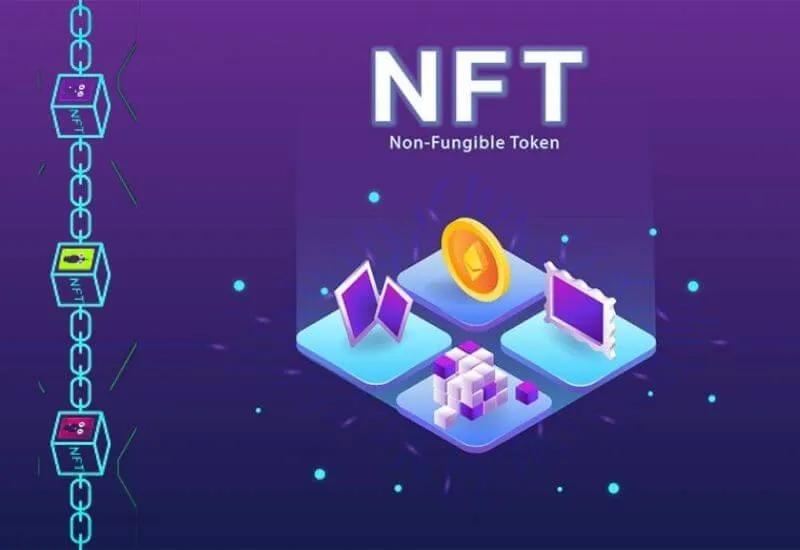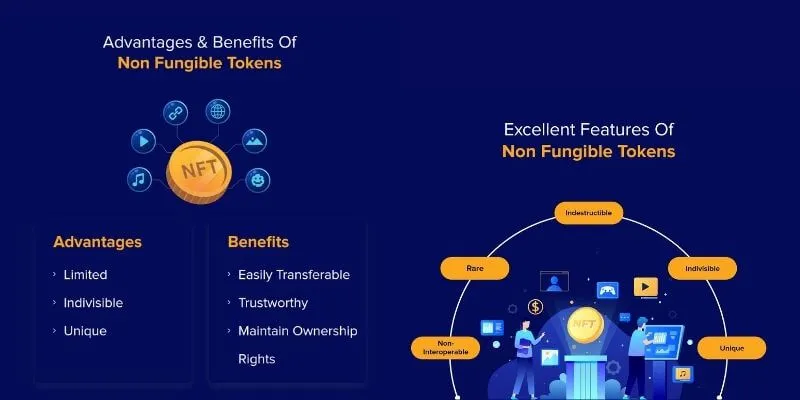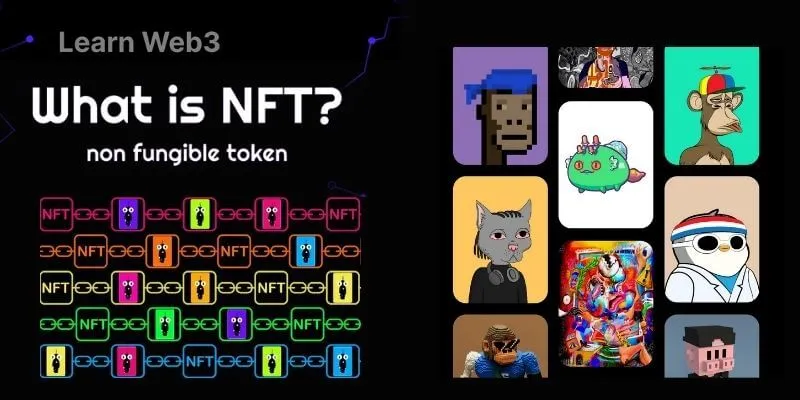What is NFT? Non Fungible Tokens Explained – NFT is a kind of trading platform that can help you raise funds and also make a lot of profit. But how can I say this? What is NFT, what are the features, how does NFT work and where can you use nft token? If you want to know more about it, then continue reading here.
Table of Contents
What is NFT?
Non-fungible tokens (NFTs) are a unique type of digital asset. Each NFT is unique and non-interchangeable with any other digital asset.
The most popular use cases for NFTs are in gaming, sports/entertainment collectibles and art. However, there are also emerging use cases in real estate, government, and charity.
NFTs have been around since 2012 but have recently exploded in popularity with $250 million in sales in the last week alone.
Most NFTs exist on the Ethereum blockchain and can be viewed using tools like OpenSea which is a decentralized marketplace for buying and selling NFTs . The largest sale on OpenSea was for a virtual piece of land called CryptoPunks for $7.5M.
How do Non Fungible Tokens Work?

NFTs are minted on a blockchain, which is a digital ledger that uses cryptographic encryption to verify the authenticity of transactions.
Blockchain technology underpins cryptocurrencies such as Bitcoin and Etherium and is the same technology that powers NFTs. The transactions are recorded in blocks that are strung together in a chain; thus the term blockchain.
The transaction data for each NFT is recorded in a new block on the blockchain, which verifies its uniqueness and serves as an indelible public record of ownership.
In this way, NFTs are similar to traditional artworks because they have a paper trail that tracks ownership over time. Both can also be sold at auction or through galleries, but unlike physical works, NFTs don’t need to be transported or stored. And there’s no limit to how many copies can be made of them.
What Are The Benefits of An NFT?

NFTs are nothing but digital assets that can be used to represent a wide range of items like art, music, videos, collectibles, and much more. These tokens are unique in their own way as they are different from each other.
They are based on blockchain technology, which means that they have their own value and cannot be replicated by anyone else. NFTs give creators the ability to sell their work the way they want to, with no restrictions.
The best part about NFTs is that they’re not only limited to artworks or trading cards. In fact, there are so many different types of items that you can purchase with NFTs! You could buy anything from a piece of land to an entire house using these tokens.
The possibilities are endless when it comes down to what kind of things you can buy using NFTs.
Now that you know what an NFT is, it’s important to understand why they’re so valuable in today’s world. Here are some benefits:
They provide proof of ownership for digital assets: One thing that makes NFTs so appealing is how easy it is for someone to create their own token and
NFTs are tradable
They can be programmed to do things
Indivisibility — The NFT owner cannot lose ownership of a part of the asset, as it is divisible into whole units only, not fractions. In other words, you can’t own half of an artwork, song or photo.
Unique — There are no copies, so there is no competition for who “owns” a particular version of an NFT. This also makes it easier to identify the original artist or creator.
Interoperability — Because Ethereum (and other blockchains) are open protocols that anyone can build on, any application or project can use them for interoperability purposes.
Benefits of NFT over traditional art pieces
NFTs are a tokenized alternative to traditional artwork. An NFT is a non fungible tokens which means that each of them is unique and cannot be interchanged or replaced with another. You can compare it to the way rare Pokemon cards are treated by collectors.
- Benefits of NFTs over traditional art pieces:
- They are more affordable than traditional art work
- They are not subject to depreciation in value as they could be stolen, damaged or destroyed like traditional art work
- You will own the right to resell the NFT if you choose to do so
- The artist will get paid directly when you buy their artwork as an NFT
If you have bought a piece of art as an NFT and it increases in popularity, you can make a profit from it
An NFT trading platform
NFTs are unique digital assets that represent unique items, such as digital art.
One of the most popular use cases for NFTs is digital art, but they can also be used to authenticate ownership of digital memorabilia like trading cards and collectibles, or for tickets to events. They’re not limited to just these three things though, there are any number of ways that NFTs can be used/
A recent example is a piece of digital art created by artist Beeple that sold at Christie’s auction house for $69 mln. The piece was purchased by a cryptocurrency investor who has amassed a fortune investing in Bitcoin and Ethereum in their early days.
Some buyers have been paying extraordinary amounts for these works of art, though, almost like a new form of investment. A few pieces recently sold for millions at Christie’s auction house, including a piece by Beeple called “Everydays: The First 5000 Days” that sold for $69 million.
Why would someone pay so much money for something they can’t even touch? Well, first of
The future of the NFT industry
The NFT industry is a booming market with already 1.3 billion USD in sales so far in 2021 and a daily exchange volume of 5 million USD.
That being said, the future of NFTs are still a bit blurry, as this new technology is still developing and adapting to the market needs.
The main challenge of the NFT industry is to find its place within the world of art.
Even though we see more and more use cases for NFTs, the most active community remains the one of artists and their collectors.
In order to keep growing, NFTs need to be accessible to all kinds of artists, but also artists need to start adopting the technology in order to expand ownership over their work.
The first blockchain to support NFTs was Ethereum, which allows anyone to create their own standard
The first use case for NFTs was in online gaming. In 2017, CryptoKitties launched as the first NFT game. Players could collect and breed cats based on their ERC-721 tokens, which were stored on the blockchain.
The game was so popular that it caused Ethereum’s network to slow down drastically at one point due to high usage.
What are the best NFTs?
The best NFTs are those that are widely accepted by the holder and holders of other NFTs (e.g. Ether, Bitcoin and Litecoin).
The most widely held NFTs today are Bitcoin, Ethereum, Litecoin and Dogecoin. Each of these has been welcomed into the community with open arms. All four offer interesting characteristics that cause people to hold them in high regard.
Bitcoin is the first truly digital currency. It’s not just a financial tool (like money or cash) but can also be used as a store of value, much like gold. It has been around for years and is recognized as a safe haven for investors who want to buy without worrying about government regulation or manipulation.
Ether is the second-largest cryptocurrency after Bitcoin, but it’s gaining ground quickly because it is more versatile than Bitcoin — it’s more like a digital currency that can be traded for goods and services at some point in the future. It’s also much easier to mine than Bitcoin, which has led to a lot of excitement over its potential.
Dogecoin is similar to Litecoin in that it’s an online currency that can be traded on exchanges through peer-to-peer transactions, but the wild popularity of Dogecoin comes from
Why are NFTs so popular now?
There’s a lot going on here that has contributed to the explosion in popularity of NFTs. Here are some of the biggest factors:
1) The value in scarcity
CryptoKitties was popular partly because it was one of the first blockchain-based games. But it also benefitted from scarcity. Each CryptoKitty is different, meaning each one is unique and special among its peers. That made them attractive to collectors who were willing to pay a lot for their favourite ones.
2) The value in authenticity
A big part of the appeal of NFTs is authenticity. As we mentioned earlier, anyone can take someone else’s photo and use it as their desktop background. An NFT makes it possible for someone to verify that they own
Takeaway: NFT is a digital art but with assets such as real estate, videos and music.
They are unique digital goods with a unique blockchain address — sort of like the equivalent of the serial number on your phone — that can be traded and sold on marketplaces like OpenSea.
Of course, not all NFTs are worth millions of dollars. Some are worth just fractions of a penny.


